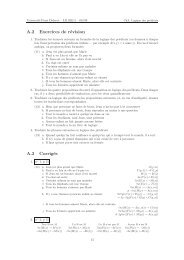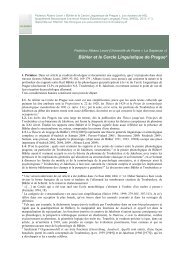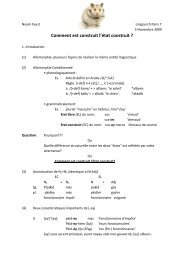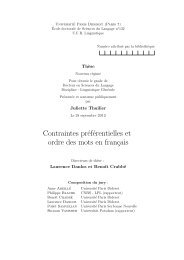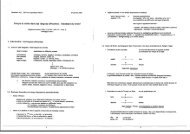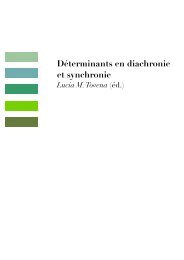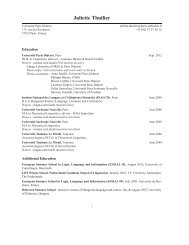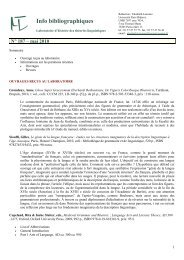Encoding path in Mauritian Creole and Bhojpuri - Laboratoire de ...
Encoding path in Mauritian Creole and Bhojpuri - Laboratoire de ...
Encoding path in Mauritian Creole and Bhojpuri - Laboratoire de ...
Create successful ePaper yourself
Turn your PDF publications into a flip-book with our unique Google optimized e-Paper software.
Sibylle Kriegel, Ralph Ludwig & Fabiola Henri<strong>Encod<strong>in</strong>g</strong> <strong>path</strong> <strong>in</strong> <strong>Mauritian</strong> <strong>Creole</strong> <strong>and</strong> <strong>Bhojpuri</strong> official year of the abolition of slavery. 5 Toussa<strong>in</strong>t (1974) writes that the effect ofthis movement was a <strong>de</strong>f<strong>in</strong>itive Indianization of Mauritius. He un<strong>de</strong>rl<strong>in</strong>es that upuntil the end of Indian immigration <strong>in</strong> 1909, the isl<strong>and</strong> received almost 450,000<strong>in</strong><strong>de</strong>ntured labourers, the majority of whom did not return to India. These <strong>in</strong><strong>de</strong>nturedlabourers were mostly <strong>Bhojpuri</strong> speakers (Neerputh 1986: 9ff; see alsoMesthrie 1991: 26), which expla<strong>in</strong>s the importance of this language <strong>in</strong> Mauritius.However, it should be emphasized that there was a consi<strong>de</strong>rable populationof speakers of other languages from South Asia, <strong>in</strong>clud<strong>in</strong>g Dravidian languageslike Tamil <strong>and</strong> Telugu, languages which a m<strong>in</strong>ority of today’s speakers still <strong>de</strong>clareas be<strong>in</strong>g their “language usually spoken at home”, 6 sometimes alongsi<strong>de</strong> <strong>Bhojpuri</strong>(see the Population Census of the Republic of Mauritius 2000). 7As far as the relationship between Indian <strong>Bhojpuri</strong> <strong>and</strong> the variety spoken <strong>in</strong>Mauritius is concerned, Baker & Ramnah (1988) carry out a <strong>de</strong>tailed comparisonbetween mo<strong>de</strong>rn <strong>Mauritian</strong> <strong>Bhojpuri</strong> <strong>and</strong> texts of twelve different geographicalvarieties of Indian <strong>Bhojpuri</strong> published by Grierson (1903), conclud<strong>in</strong>g that the“st<strong>and</strong>ard Magahi” variety comes closest to <strong>Mauritian</strong> <strong>Bhojpuri</strong> overall but thatit is apparent that <strong>Mauritian</strong> <strong>Bhojpuri</strong> does not <strong>de</strong>rive from this alone but is a“blend” of several varieties of Indian <strong>Bhojpuri</strong>.Dom<strong>in</strong>gue (1981) lists grammatical features where simplification is evi<strong>de</strong>nt,namely the system of honorifics (see below) <strong>and</strong> the notion of gen<strong>de</strong>r. The fem<strong>in</strong><strong>in</strong>emarker on the verb only cont<strong>in</strong>ues to exist <strong>in</strong> the second person s<strong>in</strong>gularpast tense of certa<strong>in</strong> archaic registers of <strong>Mauritian</strong> <strong>Bhojpuri</strong>. Moreover, accord<strong>in</strong>gto Dom<strong>in</strong>gue (1981: 7) <strong>Mauritian</strong> <strong>Bhojpuri</strong> has lost the optional adjective agreementwhich exists <strong>in</strong> Indian <strong>Bhojpuri</strong>. Dom<strong>in</strong>gue claims, moreover, that these processesof simplification are not a result of contact with <strong>Creole</strong>, but “they appearto be due to the “move” itself, to the geographical <strong>and</strong> historical distances whichhave severed the l<strong>in</strong>ks between the transplanted variety <strong>and</strong> its orig<strong>in</strong>s” (1981: 52).Baker & Ramnah (1985: 230) conclu<strong>de</strong> that “<strong>Mauritian</strong> <strong>Bhojpuri</strong> is not a radicallyrestructured form of Indian <strong>Bhojpuri</strong> <strong>and</strong> has certa<strong>in</strong>ly not un<strong>de</strong>rgone anyth<strong>in</strong>gcomparable to the process of creolization.” 8 It seems that <strong>Mauritian</strong> <strong>Bhojpuri</strong>, tospeak <strong>in</strong> terms of markedness theory, is affected by certa<strong>in</strong> processes of markednessreduction.Let us consi<strong>de</strong>r an example on the morphological level: the system of personalpronouns <strong>in</strong> Indian <strong>and</strong> <strong>Mauritian</strong> <strong>Bhojpuri</strong> (as part of the system of honorifics).The simplification processes become evi<strong>de</strong>nt if one compares both varieties of<strong>Bhojpuri</strong>:(1) System of personal pronounsIndian <strong>Bhojpuri</strong> 9 <strong>Mauritian</strong> <strong>Bhojpuri</strong> 10 <strong>Mauritian</strong> <strong>Creole</strong>1 ham ham mo2 formal: a:p tou ou<strong>in</strong>formal: tu:tofamiliar: tæ3 formal: wan ou li<strong>in</strong>formal: u:1 hamman (ke) hamni nu2 formal: a:p lo:g tou zot<strong>in</strong>formal: tuhan (ke)3 formal: u: lo:g holog zot<strong>in</strong>formal: onn h an (ke)When compared to Indian <strong>Bhojpuri</strong>, <strong>Mauritian</strong> <strong>Bhojpuri</strong> is characterized by asystem <strong>in</strong> which forms of the 2nd person <strong>and</strong> the 3rd person s<strong>in</strong>gular <strong>and</strong> pluralare reduced. We will return to this po<strong>in</strong>t <strong>in</strong> §2.3.2. <strong>Mauritian</strong> <strong>Bhojpuri</strong> is also dist<strong>in</strong>guishedfrom Indian <strong>Bhojpuri</strong> by various phonetic <strong>and</strong> morphophonologicalprocesses/modifications. For <strong>de</strong>tails concern<strong>in</strong>g the immigration of populations from the Indian sub-cont<strong>in</strong>ent toMauritius <strong>in</strong> the 18th century (thus before the arrival of <strong>in</strong><strong>de</strong>ntured labourers), see Vaughan(2005). Although Tamil, Telugu <strong>and</strong> various other languages of India are returned as “languageusually spoken <strong>in</strong> the home” <strong>in</strong> the <strong>Mauritian</strong> censuses, this does not necessarily mean that thereare any homes <strong>in</strong> which these are “usually spoken” (Philip Baker, personal communication). Accord<strong>in</strong>g to Atchia-Emmerich (2005), nowadays <strong>Bhojpuri</strong> is spoken by the majority ofIndians <strong>in</strong> Mauritius, even those who <strong>in</strong> the census <strong>in</strong>dicate that they have kept their ancestrallanguages, like the Tamils, the Marathis <strong>and</strong> the Telugus. See also Mesthrie (1991: 93ff) who speaks of simplification <strong>in</strong> the transplanted varieties.Like Baker & Ramnah (1985) for <strong>Mauritian</strong> <strong>Bhojpuri</strong>, he un<strong>de</strong>rl<strong>in</strong>es that the structural simplificationprocesses <strong>in</strong> the South African variety are not evi<strong>de</strong>nce of pidg<strong>in</strong>ization <strong>and</strong> creolization(1991: 104). See Shukla (1981: 76). Where several forms are noted, the first one <strong>in</strong>dicates the formalform, the second the <strong>in</strong>formal <strong>and</strong> the third, familiar. The <strong>in</strong>formation <strong>in</strong> this column was compiled us<strong>in</strong>g data from our own studies, wherewe transcribed <strong>Mauritian</strong> <strong>Bhojpuri</strong> us<strong>in</strong>g the writ<strong>in</strong>g conventions proposed by Hookooms<strong>in</strong>g(2004). It corresponds largely to Neerputh’s (1986: 27) table, apart from some divergences <strong>in</strong> thespell<strong>in</strong>g.2nd proofs
Sibylle Kriegel, Ralph Ludwig & Fabiola Henri<strong>Encod<strong>in</strong>g</strong> <strong>path</strong> <strong>in</strong> <strong>Mauritian</strong> <strong>Creole</strong> <strong>and</strong> <strong>Bhojpuri</strong> Concern<strong>in</strong>g the question of mutual <strong>in</strong>telligibility between H<strong>in</strong>di <strong>and</strong> <strong>Mauritian</strong><strong>Bhojpuri</strong>, 11 it is important to specify that many <strong>Mauritian</strong> <strong>Bhojpuri</strong> speakers arealso speakers of or have a (passive) competence <strong>in</strong> H<strong>in</strong>di, 12 especially s<strong>in</strong>ce youngergenerations learn H<strong>in</strong>di as heritage language at school <strong>and</strong> a majority of <strong>Mauritian</strong><strong>Bhojpuri</strong> speakers have access to televised programs <strong>in</strong> H<strong>in</strong>dustani (H<strong>in</strong>di/Urdu).Thus, there is mutual comprehension, at least among certa<strong>in</strong> speakers, <strong>and</strong> equallya permanent contact between H<strong>in</strong>di <strong>and</strong> <strong>Bhojpuri</strong> <strong>in</strong> Mauritius.Contact between <strong>Mauritian</strong> <strong>Creole</strong> <strong>and</strong> <strong>Bhojpuri</strong> <strong>Creole</strong> <strong>in</strong>fluences on <strong>Bhojpuri</strong>Generally speak<strong>in</strong>g, the ten<strong>de</strong>ncy to replace marked features by unmarked ones(mentioned above) can be attributed either to the <strong>in</strong>fluence of <strong>Creole</strong> or tothe laws of orality which show a ten<strong>de</strong>ncy towards generaliz<strong>in</strong>g the unmarkedform <strong>and</strong> which also govern (historical) creolization <strong>and</strong> the use of <strong>Bhojpuri</strong> <strong>in</strong>Mauritius. 13However, the <strong>in</strong>fluence of <strong>Creole</strong> on <strong>Bhojpuri</strong> is clearly evi<strong>de</strong>nt <strong>in</strong> the area oflexis. As will be shown <strong>in</strong> the follow<strong>in</strong>g examples, <strong>Mauritian</strong> <strong>Bhojpuri</strong> makes useof several <strong>Creole</strong> borrow<strong>in</strong>gs. 14(2) a. <strong>Mauritian</strong> <strong>Bhojpuri</strong>Bazaar se pom anye.market apple br<strong>in</strong>gb. <strong>Mauritian</strong> <strong>Creole</strong>Amenn enn pom <strong>de</strong>pi bazar.br<strong>in</strong>g apple market‘Br<strong>in</strong>g an apple from the market.’These processes of borrow<strong>in</strong>g <strong>in</strong>clu<strong>de</strong> the use of entire phrases which seem tobecome complex lexical items <strong>in</strong> <strong>Bhojpuri</strong>:(3) 15 a. <strong>Mauritian</strong> <strong>Bhojpuri</strong>Ham danbwa se nikla tha<strong>in</strong>.1 forest come.from ..1b. <strong>Mauritian</strong> <strong>Creole</strong>Mo sorti dan bwa.1 come.from forest.‘I come from the forest.’However, <strong>in</strong> the area of lexis, the extent to which <strong>Bhojpuri</strong> words are replaced by<strong>Creole</strong> equivalents varies accord<strong>in</strong>g to geographical (urban versus rural areas)<strong>and</strong> age differences. Evi<strong>de</strong>ntly, urban <strong>and</strong> younger speakers use <strong>Creole</strong> wordsmore frequently than rural or ol<strong>de</strong>r speakers. Thus, two sociol<strong>in</strong>guistic factorsare shown to be important when consi<strong>de</strong>r<strong>in</strong>g the evolution of the l<strong>in</strong>guistic ecosystemof Mauritius: urbanization <strong>and</strong> diagenerational variation. 16 Here, we willmerely make reference to these few examples concern<strong>in</strong>g lexis <strong>and</strong> will return tothe possible reciprocal <strong>in</strong>fluences on morphosyntax <strong>in</strong> the follow<strong>in</strong>g paragraph, aswell as <strong>in</strong> §3. Cf. Dom<strong>in</strong>gue’s (1981: 52) comment concern<strong>in</strong>g l<strong>in</strong>guistic awareness: “<strong>Mauritian</strong> <strong>Bhojpuri</strong>is so different from Cont<strong>in</strong>ental <strong>Bhojpuri</strong> that its speakers are not really sure that they are, <strong>in</strong><strong>de</strong>ed,speak<strong>in</strong>g that language. In fact, most of them believe that they speak some patois of H<strong>in</strong>di, verymuch like <strong>Mauritian</strong> <strong>Creole</strong> speakers believe that they speak a patois of French”. If this analysisrema<strong>in</strong>s true for many ol<strong>de</strong>r speakers, the attitu<strong>de</strong>s of younger generations of speakers havenevertheless changed <strong>in</strong>sofar as they draw a dist<strong>in</strong>ction between <strong>Bhojpuri</strong> “language of the ol<strong>de</strong>rgeneration” for many, <strong>and</strong> H<strong>in</strong>di, prestige language learnt at school. Our <strong>in</strong>formants clarify that those who studied H<strong>in</strong>di at school up to CPE (end of primaryeducation) have passive competence, i.e., they un<strong>de</strong>rst<strong>and</strong> but do not speak H<strong>in</strong>di. Those whostudy H<strong>in</strong>di <strong>in</strong> high school have an active competence. Thus Baker & Ramnah (1985: 219 ff) mention that the function of the unmarked form ofthe noun <strong>in</strong> <strong>Mauritian</strong> <strong>Bhojpuri</strong> corresponds exactly to that of the <strong>Creole</strong> Prototype. Howeverthey are unable to <strong>de</strong>term<strong>in</strong>e whether this parallel is truly due to a <strong>Creole</strong> <strong>in</strong>fluence. Baker & Ramnah (1985: 226) estimate some 1000 <strong>Creole</strong> words <strong>in</strong> <strong>Mauritian</strong> <strong>Bhojpuri</strong>,cf. also Neerputh (1986: 11). Mesthrie (1991: 153) reports examples of the transfer of <strong>Creole</strong>lexemes to South African <strong>Bhojpuri</strong> via <strong>Mauritian</strong> <strong>Bhojpuri</strong>.2nd proofs <strong>Bhojpuri</strong> <strong>in</strong>fluence on <strong>Creole</strong>It has been shown that <strong>Bhojpuri</strong> has, for its part, left several lexical traces on <strong>Creole</strong>.Baker & Ramnah (1985: 226) cite a figure of more than 300 words of Indo-Aryanorig<strong>in</strong> <strong>in</strong> <strong>Mauritian</strong> <strong>Creole</strong>, of which the majority are probably from <strong>Bhojpuri</strong>(Kriegel & Ludwig & Henri forthcom<strong>in</strong>g).Dur<strong>in</strong>g our surveys, <strong>in</strong>formants brought to light the fact that certa<strong>in</strong> <strong>Bhojpuri</strong>words have been <strong>in</strong>tegrated <strong>in</strong>to <strong>Creole</strong>, some examples be<strong>in</strong>g: 17 karay (‘fry<strong>in</strong>g We are grateful to Kumari Issur, who provi<strong>de</strong>d us with this example <strong>and</strong> who also drew ourattention to the fact that dan-bwa as a s<strong>in</strong>gle word translates as “forest” <strong>and</strong> can even be replacedby lafore where <strong>Bhojpuri</strong> is used <strong>in</strong> contexts call<strong>in</strong>g for a higher register. It would seem, then,that <strong>Bhojpuri</strong> borrows lexical items (lexemes) from various <strong>Creole</strong> registers. For more <strong>de</strong>tailed analysis of these factors, see Díaz & Ludwig & Pfän<strong>de</strong>r (2002). See Baker (1982: 314 ff.) for a methodical summary <strong>in</strong> which some of these words arefound.
Sibylle Kriegel, Ralph Ludwig & Fabiola Henri<strong>Encod<strong>in</strong>g</strong> <strong>path</strong> <strong>in</strong> <strong>Mauritian</strong> <strong>Creole</strong> <strong>and</strong> <strong>Bhojpuri</strong> We have already mentioned the fact that several French-lexified <strong>Creole</strong>s, notablySeychelles <strong>Creole</strong>, which is similar to <strong>Mauritian</strong> <strong>Creole</strong> <strong>in</strong> many respects, 21 generalizedthe form <strong>de</strong>rived from French vous to formal <strong>and</strong> <strong>in</strong>formal registers. We couldalso consi<strong>de</strong>r a noteworthy observation concern<strong>in</strong>g another variety of “exported”<strong>Bhojpuri</strong> from the context of <strong>in</strong><strong>de</strong>ntured labour: accord<strong>in</strong>g to Mesthrie (1991: 100),South African <strong>Bhojpuri</strong> lost the dist<strong>in</strong>ction between formal <strong>and</strong> <strong>in</strong>formal both onthe verb <strong>and</strong> on the pronoun. Thus, two varieties (other French-lexified creoles <strong>and</strong>South African <strong>Bhojpuri</strong>) which are similar to the two <strong>Mauritian</strong> languages lost theformal/<strong>in</strong>formal dist<strong>in</strong>ction. If the dist<strong>in</strong>ction is ma<strong>in</strong>ta<strong>in</strong>ed <strong>in</strong> <strong>Mauritian</strong> <strong>Creole</strong>as well as <strong>in</strong> <strong>Mauritian</strong> <strong>Bhojpuri</strong>, although this is manifested at different levels, wepropose that this could be due to the reciprocal <strong>in</strong>fluence <strong>and</strong> <strong>in</strong>teraction between<strong>Mauritian</strong> <strong>Creole</strong> <strong>and</strong> <strong>Mauritian</strong> <strong>Bhojpuri</strong>. We therefore hypothesize that this is acase of convergence between <strong>Mauritian</strong> <strong>Creole</strong> <strong>and</strong> <strong>Mauritian</strong> <strong>Bhojpuri</strong>.The expression of PathThe semantic categories: Ablative, allative <strong>and</strong> essiveLet us first exam<strong>in</strong>e the semantic categories <strong>in</strong>volved <strong>in</strong> a local situation. For thispurpose, we will adopt the conceptual <strong>and</strong> term<strong>in</strong>ological suggestions of Lehmann(1992) <strong>and</strong> Talmy (1985). A local situation presents, accord<strong>in</strong>g to Lehmann (1992),the follow<strong>in</strong>g structure (see also Michaelis (this volume) for its application tocreole languages): A mov<strong>in</strong>g or located object or Figure 22 is <strong>in</strong>volved <strong>in</strong> a situation<strong>and</strong> locally related or oriented with respect to a local region of a reference object,which can also be called Ground. It is important to dist<strong>in</strong>guish between the localregion or place of the reference object <strong>and</strong> the orientation or Path (Talmy 1985).In this paper, we are particularly <strong>in</strong>terested <strong>in</strong> the cod<strong>in</strong>g of Path. 23 We dist<strong>in</strong>guishthe follow<strong>in</strong>g types of Path: essive (at rest, “to be at”), allative (motion-to, “to goto”) <strong>and</strong> ablative (motion-from, “to come from”) <strong>and</strong> will pay special attention tothe cod<strong>in</strong>g of the ablative relation <strong>in</strong> <strong>in</strong>transitive movement. The separation of Seychelles <strong>Creole</strong> from <strong>Mauritian</strong> <strong>Creole</strong> predates large-scale Indianimmigration <strong>in</strong> Mauritius. Concern<strong>in</strong>g this po<strong>in</strong>t, we follow Talmy (1985: 61) who gives the follow<strong>in</strong>g <strong>de</strong>f<strong>in</strong>itions:“The terms “Figure” <strong>and</strong> “Ground” are taken from Gestalt psychology but we give them a dist<strong>in</strong>ctsemantic <strong>in</strong>terpretation here: the Figure is a mov<strong>in</strong>g or conceptually movable object whose<strong>path</strong> or site is at issue; the Ground is a reference frame, or a reference po<strong>in</strong>t stationary with<strong>in</strong> areference-frame with respect to which the Figure’s <strong>path</strong> or site is characterized.” The “Path” (with a capital P) is the course followed or site occupied by the Figure objectwith respect to the Ground object.2nd proofsThe unmarked expressionIn French, the preposition <strong>de</strong> normally enco<strong>de</strong>s the ablative relation <strong>and</strong> the prepositionà enco<strong>de</strong>s the allative (<strong>and</strong> essive) relation. These two prepositions havebeen lost dur<strong>in</strong>g creolization <strong>and</strong> have not been replaced by other prepositions<strong>in</strong> most varieties of <strong>Mauritian</strong> <strong>Creole</strong>. In ablative <strong>and</strong> allative contexts, the verbcomb<strong>in</strong>es with the Ground without any Path-<strong>de</strong>not<strong>in</strong>g preposition:Examples for the ablative relation:(7) <strong>Mauritian</strong> <strong>Creole</strong>a. Mo sorti Vakwa.1 come.from Vacoas‘I’m com<strong>in</strong>g from Vacoas.’b. Dadi sort lakanpagn.Gr<strong>and</strong>ma come.from countrysi<strong>de</strong>‘Gr<strong>and</strong>ma comes from the countrysi<strong>de</strong>’.c. Zak sorti kot Pol.Jacques come.from Paul‘Jacques is com<strong>in</strong>g from Paul’s (place).’Examples for the allative relation:(8) <strong>Mauritian</strong> <strong>Creole</strong>a. Mo pe al Vakwa.1 go Vacoas‘I am go<strong>in</strong>g to Vacoas.’b. Zak pe al kot Pol.Jacques go Paul‘Jacques is go<strong>in</strong>g to Paul’s (place).’The zero-expression of ablative <strong>and</strong> allative <strong>in</strong> <strong>Mauritian</strong> <strong>Creole</strong> corresponds tothe strategy employed by other French-lexified creoles. Here we will limit ourcomparison to Lesser Antillean <strong>Creole</strong>, especially Gua<strong>de</strong>loupean <strong>Creole</strong> <strong>and</strong>Dom<strong>in</strong>ican <strong>Creole</strong>. Examples for the ablative relation:(9) a. Dom<strong>in</strong>ican <strong>Creole</strong> (Ludwig & Telchid & Bruneau-Ludwig 2001: 39)Sété bagay ki té sòti lòt pèyi kòmisyon th<strong>in</strong>g come.from other country goodski sòti lòt pèyi. come.from other country‘These were th<strong>in</strong>gs which came from other countries, goods which camefrom other countries.’b. Gua<strong>de</strong>loupean <strong>Creole</strong> (Ludwig & Montbr<strong>and</strong> & Poullet & Telchid 2002: 296)Ou sòti lwen.2 come.from far‘You’ve come from far.’
Sibylle Kriegel, Ralph Ludwig & Fabiola Henri<strong>Encod<strong>in</strong>g</strong> <strong>path</strong> <strong>in</strong> <strong>Mauritian</strong> <strong>Creole</strong> <strong>and</strong> <strong>Bhojpuri</strong> Examples for the allative relation:(10) Gua<strong>de</strong>loupean <strong>Creole</strong> (G. Hazaël-Massieux 1989: 207)Mwen kalé Paris.1 .go Paris‘I am go<strong>in</strong>g to Paris.’We also refer the rea<strong>de</strong>r to Michaelis (this volume), who works with examplesfrom Seychelles <strong>Creole</strong> correspond<strong>in</strong>g to our examples of unmarked expressions <strong>in</strong>(7)–(10) from <strong>Mauritian</strong> <strong>Creole</strong> <strong>and</strong> Lesser Antillean <strong>Creole</strong>. In Seychelles <strong>Creole</strong>,as <strong>in</strong> our examples (7)–(10), the ablative relation <strong>and</strong> the dist<strong>in</strong>ction between ablative<strong>and</strong> allative relation is not grammatically enco<strong>de</strong>d.Seychelles <strong>Creole</strong>(11) Mon al dan bwa.1 go <strong>in</strong> forest‘I’m go<strong>in</strong>g <strong>in</strong>to the forest.’(12) Mon sorti dan 24 bwa.1 come.from <strong>in</strong> forest‘I’m com<strong>in</strong>g from the forest.’Accord<strong>in</strong>g to Michaelis (this volume), many creoles behave like Seychelles <strong>Creole</strong><strong>in</strong> that they do not express Path overtly; the appropriate <strong>in</strong>terpretation has tobe <strong>in</strong>ferred from the semantics of the verb. Even if we suggest, for <strong>in</strong>stance, that<strong>in</strong> Lesser Antillean <strong>Creole</strong> serial verb constructions must be consi<strong>de</strong>red <strong>in</strong> theexpression of Path (see §3.3), Michaelis’s ma<strong>in</strong> hypothesis is of great significanceto our paper: She claims that those constructions not conform<strong>in</strong>g to the encod<strong>in</strong>gstrategies <strong>in</strong> the European base languages are attributable to substrate <strong>in</strong>fluence.In this paper, we will not be look<strong>in</strong>g at the possible substrate languages of <strong>Mauritian</strong><strong>Creole</strong> but we will focus on a construction type current <strong>in</strong> some varieties of<strong>Mauritian</strong> <strong>Creole</strong> which are <strong>in</strong>fluenced by <strong>Bhojpuri</strong>, which can be qualified as be<strong>in</strong>gan adstrate language for <strong>Mauritian</strong> <strong>Creole</strong>. Our results will po<strong>in</strong>t to the same trendas that suggested by Michaelis (this volume) <strong>and</strong> Essegby (2005). In the doma<strong>in</strong> ofexpress<strong>in</strong>g Path, language contact seems to play a crucial role.The marked expression: Comparison with Lesser Antillean <strong>Creole</strong>When it comes to the more explicit expression of directionality (Path), we observethat <strong>Mauritian</strong> <strong>Creole</strong> favours different strategies from Lesser Antillean <strong>Creole</strong>which, once more, is used here as a po<strong>in</strong>t of comparison. Note that dan refers to the local region of the reference object or Ground <strong>and</strong> does notexpress Path.Lesser Antillean <strong>Creole</strong> can make use of prepositions, as shown by the follow<strong>in</strong>gexamples from Gua<strong>de</strong>loupean <strong>Creole</strong> <strong>and</strong> Dom<strong>in</strong>ican <strong>Creole</strong>.(13) Gua<strong>de</strong>loupean <strong>Creole</strong> (Ludwig & Telchid & Bruneau-Ludwig 2001: 78)Manman-y té ka voyé-y fè konmisyonmother-3. send-3. do err<strong>and</strong>sa pyé jous Twarivyè.on foot to Trois-Rivières‘His mother used to send him to run err<strong>and</strong>s on foot all the way to Trois-Rivières.’(14) Dom<strong>in</strong>ican <strong>Creole</strong> (Ludwig & Telchid & Bruneau-Ludwig 2001: 40)Épi yo ay monté jik anho koté mouché James.<strong>and</strong>.then 3 go ascend to at.the.top Mister James‘And they went right (all the way) up to Mr James’s house…’In addition, a wi<strong>de</strong>spread method of express<strong>in</strong>g directionality <strong>in</strong> traditionalbasilectal Lesser Antillean <strong>Creole</strong> is the predicative serial construction, as <strong>in</strong> (15)(allative touché) <strong>and</strong> (16) (ablative + allative) (this construction does not reallyform part of younger generations’ competence nowadays):(15) Gua<strong>de</strong>loupean <strong>Creole</strong> (Ludwig 1996: 248)I pwan vwati, touché Lapwent.3 take car touch La Po<strong>in</strong>te‘He went (all the way to) La Po<strong>in</strong>te by car.’(16) I pati Bastè rivé Lapwent.3 leave Basse-Terre arrive La Po<strong>in</strong>te‘He left Basse-Terre <strong>and</strong> got to/got as far as La Po<strong>in</strong>te.’Serial constructions <strong>in</strong> Gua<strong>de</strong>loupean <strong>Creole</strong> <strong>and</strong> Dom<strong>in</strong>ican <strong>Creole</strong> may alsoexpress directionality <strong>in</strong> relation to the speaker’s perspective, without <strong>in</strong>clud<strong>in</strong>g a(different or explicit) po<strong>in</strong>t of <strong>de</strong>parture or arrival. 25 An example is (17):(17) Gua<strong>de</strong>loupean <strong>Creole</strong> (Ludwig & Montbr<strong>and</strong> & Poullet & Telchid 2002: 257)I ka pléré, menné-y alé!3 ipfv weep lead-3. go‘He/She is cry<strong>in</strong>g, take him/her away!’In <strong>Mauritian</strong> <strong>Creole</strong>, serial constructions only play a m<strong>in</strong>imal role (see Kriegel &Ludwig & Henri, forthcom<strong>in</strong>g), whereas they play an important role <strong>in</strong> severalbasi lectal varieties of French-lexified <strong>Creole</strong>s. As for prepositional markers, the relationshipis reversed: they play an important role <strong>in</strong> <strong>Mauritian</strong> <strong>Creole</strong>. Particularly noteworthy One could argue that Ablative <strong>in</strong>clu<strong>de</strong>s this explicit expression of the po<strong>in</strong>t of <strong>de</strong>parture;nevertheless, it is clear that constructions like (17) semantically <strong>in</strong>clu<strong>de</strong> the i<strong>de</strong>a of a – nonspecified –reference po<strong>in</strong>t which constitutes the po<strong>in</strong>t of <strong>de</strong>parture for an <strong>in</strong>tentional directional movement(<strong>in</strong> this case, the situation of communication).2nd proofs
Sibylle Kriegel, Ralph Ludwig & Fabiola Henri<strong>Encod<strong>in</strong>g</strong> <strong>path</strong> <strong>in</strong> <strong>Mauritian</strong> <strong>Creole</strong> <strong>and</strong> <strong>Bhojpuri</strong> is the frequency of occurrence of <strong>de</strong>pi ‘from’, which especially characterizes the<strong>Bhojpuri</strong>-<strong>in</strong>fluenced variety, as has already been mentioned by Baker (1972: 112, 117).Different functions <strong>and</strong> uses of <strong>de</strong>pi (< <strong>de</strong>puis) <strong>in</strong> <strong>Mauritian</strong> <strong>Creole</strong>We will now focus on the <strong>Mauritian</strong> <strong>Creole</strong> preposition <strong>de</strong>pi, <strong>de</strong>rived from French<strong>de</strong>puis. It is undoubtedly the most frequently used explicit <strong>path</strong> marker <strong>in</strong> <strong>Mauritian</strong><strong>Creole</strong>, serv<strong>in</strong>g a variety of functions which sometimes seem <strong>in</strong>comprehensibleif one is unaware of the contact situation between <strong>Mauritian</strong> <strong>Creole</strong> <strong>and</strong><strong>Mauritian</strong> <strong>Bhojpuri</strong>. We will first list the pr<strong>in</strong>cipal functions: Local po<strong>in</strong>t of <strong>de</strong>parture (ablative)The examples <strong>in</strong> (18)–(21) illustrate the most basic local use of <strong>de</strong>pi, the simpleablative (‘from’) use.(18) Mo papa sort <strong>de</strong>pi Sesel, li ’nn v<strong>in</strong>i pu travay dan Moris. father come.from Seychelles 3 come for work Mauritius‘My father comes from the Seychelles, he came to work <strong>in</strong> Mauritius (…)’.(Bord la Mer 82)(19) Kot to pou ale <strong>de</strong>pi isi?where 2 go here‘Where will you go from here?’(Dev Virahsawmy Hamlet 2, http://pages.<strong>in</strong>tnet.mu/<strong>de</strong>velog/)(20) Pyer f<strong>in</strong>n zet so bann vye soulye <strong>de</strong>pi enn pon.Pyer throw .3 old shoe bridge‘Pyer threw his old shoes off a bridge.’(21) Mo kapav tir sa <strong>de</strong>pi la?1 can remove here‘Can I (re)move this from there?’Depi ‘from’ <strong>and</strong> dan ‘<strong>in</strong>’ may also occur together, as illustrated <strong>in</strong> (22)–(24).(22) Mo ’nn tir mo lakle <strong>de</strong>pi dan mo sak.1 take.out .1 key .1 bag‘I took the key out of my bag.’(23) Mo sorti <strong>de</strong>pi dan lafore.1 come.from forest‘I am com<strong>in</strong>g out of the forest.’(24) Li tir so l<strong>in</strong>et <strong>de</strong>pi dan so pos.3 take.out glasses pocket.‘He took his glasses out of his pocket.’ (Virahsawmy, Dev: L<strong>in</strong>conns<strong>in</strong>g F<strong>in</strong>alay,http://pages.<strong>in</strong>tnet.mu/<strong>de</strong>velog/teatmlfl.htm)These comb<strong>in</strong>ations of <strong>de</strong>pi <strong>and</strong> dan match the conceptual structure of a local situationperfectly: The preposition dan refers to the local region of the reference objector Ground, <strong>and</strong> the preposition <strong>de</strong>pi refers to the Path. But language contact may alsohave played a <strong>de</strong>term<strong>in</strong><strong>in</strong>g role <strong>in</strong> creat<strong>in</strong>g these patterns, as we will see <strong>in</strong> §4.2.2. Local po<strong>in</strong>t of <strong>de</strong>parture <strong>and</strong> arrival (ablative + allative)As expected, the preposition <strong>de</strong>pi may occur together with an allative expressionmarked by ziska ‘to’, to express the beg<strong>in</strong>n<strong>in</strong>g <strong>and</strong> end of a <strong>path</strong>, as seen <strong>in</strong>(25)–(27). Aga<strong>in</strong>, both <strong>de</strong>pi <strong>and</strong> ziska can comb<strong>in</strong>e with dan ‘<strong>in</strong>’ (see 25).(25) Depi dan kan lao li v<strong>in</strong>i ziska dan kan anba. camp 3 come camp bottom‘He’s go<strong>in</strong>g from the higher camp right down to the one at the bottom.’(Bord La Mer 82)(26) Depi Vakwa ziska Maybour Pol <strong>in</strong>n dormi dan loto. Vacoas Mahébourg Paul sleep car‘Paul has been sleep<strong>in</strong>g <strong>in</strong> the car from Vacoas to port Louis.’(27) Li nn get mwa <strong>de</strong>pi lao ziska anba.3 look.at 1 top bottom‘He looked at me from head to toe.’ (He looked at me from top to bottom.)But it is less expected that <strong>de</strong>pi should also be used to co<strong>de</strong> the allative relation <strong>in</strong>such patterns:(28) a. Depi lao <strong>de</strong>pi anba, ena bokou pou marse. top bottom much to walk‘(To go) from top to bottom, there’s a lot of walk<strong>in</strong>g to do.’b. Depi sannmars <strong>de</strong>pi lagar ena trafik. champs.<strong>de</strong>.mars gare traffic‘From Champs <strong>de</strong> Mars up to the station, the traffic is jammed.’This rather <strong>in</strong>terest<strong>in</strong>g use of <strong>de</strong>pi <strong>in</strong>stead of ziska to mark the allative, which isespecially characteristic of the Indo-<strong>Mauritian</strong> variety of the <strong>Creole</strong>, was alreadynoted by Baissac (1880):Depuis, dipis. Depuis ici jusque-là, Dipis ici zousqu’à-là; mais le créole disait avant qu’ilconnût zousqu’à ou zisquà, jusque, au lieu <strong>de</strong>: J’ai sauté <strong>de</strong>puis ici jusque là, Mo té sautédipis là, dipis là, ce qui était plus orig<strong>in</strong>al. (Baissac 1880: 78) 26In Baissac’s old texts we f<strong>in</strong>d an attestation of this use, see example (42). “From, dipis. From here to there, Dipis ici zousquà-là; but the <strong>Creole</strong> would say before heknew zousqu’à or zisquà, ‘to’, <strong>in</strong>stead of: I jumped from here to there, Mo té sauté dipis là, dipislà, which was <strong>in</strong> fact more orig<strong>in</strong>al.”2nd proofs
Sibylle Kriegel, Ralph Ludwig & Fabiola Henri<strong>Encod<strong>in</strong>g</strong> <strong>path</strong> <strong>in</strong> <strong>Mauritian</strong> <strong>Creole</strong> <strong>and</strong> <strong>Bhojpuri</strong> Temporal beg<strong>in</strong>n<strong>in</strong>gLike its French source word <strong>de</strong>puis, <strong>de</strong>pi may express a temporal beg<strong>in</strong>n<strong>in</strong>g.(29) Depi katrer granmat<strong>in</strong> gardyen v<strong>in</strong>n tap laport ek four.o’clock morn<strong>in</strong>g watchman come knock door withso gro dibwa. big wood‘S<strong>in</strong>ce four o’clock this morn<strong>in</strong>g, the watchman came knock<strong>in</strong>g at the doorwith his big stick.’ (Bord La Mer, 82)(30) Depi yer li ’nn al Porlwi. yesterday 3 go Port-Louis‘S<strong>in</strong>ce yesterday he left for Port-Louis.’ Temporal beg<strong>in</strong>n<strong>in</strong>g <strong>and</strong> endpo<strong>in</strong>tThe comb<strong>in</strong>ations <strong>de</strong>pi-ziska <strong>and</strong> <strong>de</strong>pi-<strong>de</strong>pi, which we saw <strong>in</strong> §3.4.2, can alsoexpress temporal beg<strong>in</strong>n<strong>in</strong>g <strong>and</strong> endpo<strong>in</strong>t:(31) <strong>de</strong>pi sizer ziska witer six.o’clock eight.o’clock‘from six o’clock to eight o’clock’(32) <strong>de</strong>pi sizer <strong>de</strong>pi witer six.o’clock eight.o’clock‘from six o’clock to eight o’clock’ Temporal endpo<strong>in</strong>tDepi may also express a temporal endpo<strong>in</strong>t <strong>in</strong> the absence of an expression for astart<strong>in</strong>g po<strong>in</strong>t:(33) Sa tr<strong>in</strong> la pou gouvernman sa, li ed <strong>de</strong>pi ler. tra<strong>in</strong> to government 3 help hour‘This tra<strong>in</strong> belongs to the government, it has been useful up to today.’ Exten<strong>de</strong>d usesLike ablative markers of other languages, <strong>de</strong>pi may be used <strong>in</strong> a range of more abstract(nonspatial, nontemporal) functions. One is a human source:(34) Me anmemtan nou pe truv osi bann priz <strong>de</strong> pozisyonbut same.time 1 f<strong>in</strong>d too statement of op<strong>in</strong>ioneklere dan lapres ki kapav amenn <strong>in</strong>pe progre pu langazenlightened press can lead some progress for languageKreol – ki li <strong>de</strong>pi Gilbert Ahnee, J.Clau<strong>de</strong> <strong>de</strong> Lestrac, (…) e lezot.<strong>Creole</strong> 3 Gilbert Ahnee J. Clau<strong>de</strong> <strong>de</strong> Lestrac <strong>and</strong> other‘But similarly/at the same time we are witness<strong>in</strong>g enlightened statements ofop<strong>in</strong>ion <strong>in</strong> the press which could mean progress for the <strong>Creole</strong> language – be itfrom Gilbert Ahnee, J.Clau<strong>de</strong> <strong>de</strong> Lestrac, Mme. Alfred, (…) <strong>and</strong> others.’ (Lalit17/02/2004 http://www.lalitmauritius.com/)(35) Nou ’nn gagn enn papye <strong>de</strong>pi gouvernman.1 get papier from government‘We (have) received a document from the government.’Another use is the <strong>de</strong>limitation of an extension of patients (this is similar to“local function”):(36) Depi twa, <strong>de</strong>pi to mama zot tou pou kone ar mwa.from 2 from .2 mother 2 all know with 1‘You <strong>and</strong> your mother, you’re go<strong>in</strong>g to get a good beat<strong>in</strong>g.’(lit. “From you to your mother…’)In (37), we see a more abstract po<strong>in</strong>t of <strong>de</strong>parture, <strong>and</strong> <strong>in</strong> (38) <strong>de</strong>pi <strong>de</strong>notes a partitiverelation or orig<strong>in</strong>.(37) Mo byen satisfe pou truv li disparet <strong>de</strong>pi mo lavi (…)1 very satisfied f<strong>in</strong>d 3 disappear from life‘I’m content to see him disappear from my life…’(38) Dimoun sorti <strong>de</strong>pi diferan klas sosial, diferan group etnikpeople come.from from different class social different group ethnicek kars, diferan okipasion pe monte-<strong>de</strong>san.with caste different occupation go.up-go.down‘People from different social classes, different ethnic groups <strong>and</strong> castes, differentoccupations, go <strong>and</strong> come.’ (Virahsawmy Dev: Prezidan Otelo, http://pages.<strong>in</strong>tnet.mu/<strong>de</strong>velog/<strong>in</strong><strong>de</strong>x2.htm) Depi <strong>in</strong> old textsExcept perhaps the exten<strong>de</strong>d uses, all the functions of <strong>de</strong>pi, <strong>de</strong>pi-ziska, <strong>and</strong> even <strong>de</strong>pi<strong>de</strong>piare attested <strong>in</strong> ol<strong>de</strong>r texts. We will only cite a few examples of the local function:(39) Lher la foul conne ça, zot sivré li a piéwhen crowd know this 3 follow 3. by footdipi tou zot la vil. all 3. town‘The people heard about it, <strong>and</strong> so they left their towns <strong>and</strong> followed him byl<strong>and</strong>.’ (Matthew 14, 13, translation by An<strong>de</strong>rson 1885)2nd proofs
Sibylle Kriegel, Ralph Ludwig & Fabiola Henri<strong>Encod<strong>in</strong>g</strong> <strong>path</strong> <strong>in</strong> <strong>Mauritian</strong> <strong>Creole</strong> <strong>and</strong> <strong>Bhojpuri</strong> (40) (…) soley va v<strong>in</strong>e noar, la l<strong>in</strong>e na pa vasoleil become black moon donne so clarté, é zétoal va tombé dipi dan lé ciel (…)give clarté <strong>and</strong> star fall heaven‘Soon after the trouble of those days, the sun will grow dark, the moon will nolonger sh<strong>in</strong>e, the stars will fall from heaven…’ (Matthew 24, 29, translation byAn<strong>de</strong>rson 1885)(41) Avla ki lherla mem, voal dan le tampl ti décir an dé,voilà moment veil temple tear twodipi laho ziska anba, (…) top bottom‘Then the curta<strong>in</strong> hang<strong>in</strong>g <strong>in</strong> the temple was torn <strong>in</strong> two from top to bottom…’(Matthew 27, 51, translation by An<strong>de</strong>rson 1885)(42) Mais so cloisons laçambe là napas dibois napas plances: dipis enbut partition room wood planks haut, dipis en bas toute loison nèque éne gr<strong>and</strong> gr<strong>and</strong> laglace même. top bottom all partition just big big mirror même‘But the partition <strong>in</strong> his/her room is not ma<strong>de</strong> of wood or boards: from top tobottom the partition is a big, big mirror.’ (Baissac 1880: 56)The contribution of French <strong>and</strong> <strong>Bhojpuri</strong> to<strong>Mauritian</strong> <strong>Creole</strong> Path expressionsFrench <strong>in</strong>fluenceFrench draws upon two ma<strong>in</strong> prepositional formulas to express Path or directionality(po<strong>in</strong>t of <strong>de</strong>parture <strong>and</strong> po<strong>in</strong>t of arrival): <strong>de</strong> … à <strong>and</strong> <strong>de</strong>puis … jusqu’à. The<strong>de</strong>puis … jusqu’à construction marks duration, extent <strong>and</strong> cont<strong>in</strong>uity <strong>in</strong> a local,temporal or more abstract sense. It should, however, be stressed that the temporaluses of <strong>de</strong>puis are much more frequent <strong>in</strong> contemporary French. It was found that<strong>in</strong> the oral corpus CORPAIX, only 5 out of 234 occurrences of <strong>de</strong>puis are used <strong>in</strong>a local sense (Berthille Pallaud, personal communication). However, from a diachronicperspective, the primary use is the local one (see Haspelmath 1997: 139).Thus, French, as the lexifier language dur<strong>in</strong>g creolization <strong>and</strong> as a currentadstrate, expla<strong>in</strong>s: <strong>de</strong>pi, even though <strong>de</strong>pi seems unmarked whencompared to French <strong>de</strong>pi-ziska (semantic contiguity <strong>in</strong> general) <strong>de</strong>pi for the partitive <strong>and</strong> possessive (French as an adstrate)The <strong>in</strong>fluence of French, however, does not expla<strong>in</strong>:<strong>de</strong>pi as an ablative marker <strong>in</strong> <strong>Mauritian</strong> <strong>Creole</strong>; French alsoacted as a lexifier language for other creoles <strong>in</strong> which, however, this markerdid not un<strong>de</strong>rgo extension of mean<strong>in</strong>g <strong>and</strong> where serial constructions are usedmore predom<strong>in</strong>antly (cf. the example of Gua<strong>de</strong>loupean <strong>Creole</strong>)<strong>de</strong>pi-ziska to <strong>de</strong>pi-<strong>de</strong>pi<strong>de</strong>pi dan <strong>de</strong>pi <strong>in</strong> the Indo-<strong>Mauritian</strong>variety of <strong>Creole</strong> (cf. §4.2)<strong>Bhojpuri</strong> <strong>in</strong>fluence The hypothesis – mark<strong>in</strong>g at the lectal levelWe propose that <strong>Bhojpuri</strong> played a critical role <strong>in</strong> the generalization of <strong>de</strong>pi as anablative <strong>and</strong> sometimes allative marker. Proof of the plausibility of this hypothesismay first be sought <strong>in</strong> lectal usages of <strong>de</strong>pi:i. Depi used as an ablative marker, si<strong>de</strong> by si<strong>de</strong> with the zero marker (cf. example18: Mo papa sort <strong>de</strong>pi Sesel vs. Mo papa sort Ø Sesel) is a peculiarity of theIndo-<strong>Mauritian</strong> variety of the <strong>Creole</strong>.ii. As we briefly mentioned <strong>in</strong> §3.4, the ten<strong>de</strong>ncy to replace ziska ‘until’ by <strong>de</strong>pi ischaracteristic of the Indo-<strong>Mauritian</strong> variety of <strong>Creole</strong>, many of whose speakersare also <strong>Bhojpuri</strong> speakers (see examples (28–b) <strong>and</strong> (32)).We will revisit this hypothesis of lectal mark<strong>in</strong>g <strong>in</strong> §4.2.3 after exam<strong>in</strong><strong>in</strong>g datawhich would expla<strong>in</strong> the transmission of structural features from <strong>Bhojpuri</strong> to <strong>Creole</strong>. The particle se <strong>in</strong> <strong>Bhojpuri</strong>: contact with <strong>Creole</strong>In <strong>Mauritian</strong> <strong>Bhojpuri</strong>, the postposition se (see examples (2) <strong>and</strong> (3)) is used as anablative marker; it is the range of functions <strong>and</strong> the frequency of use of this postpositionwhich were the <strong>de</strong>term<strong>in</strong><strong>in</strong>g factors for the generalization of <strong>de</strong>pi <strong>in</strong> <strong>Creole</strong>.The postposition se is a feature of Indian <strong>Bhojpuri</strong> <strong>and</strong> also appears <strong>in</strong> other<strong>Bhojpuri</strong> varieties, for example South African <strong>Bhojpuri</strong>. 27 We will conf<strong>in</strong>e ourexamples to cases where <strong>de</strong>pi is used as an ablative marker. For Indian <strong>Bhojpuri</strong> se, Mesthrie (1991: 262) shows a range of functions which cover a relativelylarge semantic doma<strong>in</strong>. However, illustrations are lack<strong>in</strong>g: “The ma<strong>in</strong> postpositions are: (…)(b) se – cover<strong>in</strong>g the roles “source”, “comitative”, “<strong>in</strong>strument” <strong>and</strong> “force” (to be <strong>de</strong>signated “”).”2nd proofs
Sibylle Kriegel, Ralph Ludwig & Fabiola Henri<strong>Encod<strong>in</strong>g</strong> <strong>path</strong> <strong>in</strong> <strong>Mauritian</strong> <strong>Creole</strong> <strong>and</strong> <strong>Bhojpuri</strong> (43) Indian <strong>Bhojpuri</strong> (Shukla 1981: 161)Lalit pul h se ku: d-i:.Lalit bridge from jump-2..‘Lalit will jump from the bridge.’(44) South African <strong>Bhojpuri</strong> (Mesthrie 1991: 257)Bāgh jangal se nikral.tiger jungle emerge.3‘The tiger emerged from the jungle.’(45) Indian <strong>Bhojpuri</strong>Ham bharat se ayal hai.1 India come ‘I come from India.’(46) Indian <strong>Bhojpuri</strong>Perre se ghir gal ba.tree escape.3.above go ‘He fell from the tree.’(47) Indian <strong>Bhojpuri</strong>Bharat se ham Mauritius ayli.India 1 Maurice go.1‘I went from India to Mauritius Isl<strong>and</strong>.’The marker se plays a central role <strong>in</strong> the <strong>Mauritian</strong> <strong>Bhojpuri</strong> system, <strong>and</strong> the<strong>Creole</strong> translations (the b sentences <strong>in</strong> the follow<strong>in</strong>g examples) clearly show thefunctional equivalence with <strong>de</strong>pi.(48) a. <strong>Mauritian</strong> <strong>Bhojpuri</strong>Ham ghar se awa tha<strong>in</strong>.1 house come ..1b. <strong>Mauritian</strong> <strong>Creole</strong>Mo pe v<strong>in</strong>i <strong>de</strong>pi lakaz.1 come house‘I’m com<strong>in</strong>g from the house.’(49) 28 a. <strong>Mauritian</strong> <strong>Bhojpuri</strong>Bazaar se pom anye.market apple br<strong>in</strong>gb. <strong>Mauritian</strong> <strong>Creole</strong>Amenn enn pom <strong>de</strong>pi bazar.br<strong>in</strong>g apple market‘Br<strong>in</strong>g an apple from the market.’ Example (49) repeats example (2).(50) a. <strong>Mauritian</strong> <strong>Bhojpuri</strong>Hai sab <strong>in</strong>formasion hamni ke <strong>in</strong>ternet se milal ba. all <strong>in</strong>formation 1 <strong>in</strong>ternet get b. <strong>Mauritian</strong> <strong>Creole</strong>Tou sa bann l<strong>in</strong>formasion la, nou ’nn gagnall <strong>in</strong>formation 1 getli <strong>de</strong>pi <strong>in</strong>ternet.3. <strong>in</strong>ternet‘All this <strong>in</strong>formation we found on the <strong>in</strong>ternet.’The followi<strong>in</strong>g examples show po<strong>in</strong>t of <strong>de</strong>parture <strong>and</strong> po<strong>in</strong>t of arrival <strong>in</strong> a s<strong>in</strong>gle sentence.Po<strong>in</strong>t of arrival may be expressed by the postposition le, whose use is optional.(51) a. <strong>Mauritian</strong> <strong>Bhojpuri</strong>Ham ego taksi leni Vacoas se sahar (le).1 taxi take.1 Vacoas Port-Louis b. <strong>Mauritian</strong> <strong>Creole</strong>Mo ’nn pran enn taksi <strong>de</strong>pi Vakwa ziska Porlwi.1 take taxi Vacoas Port-Louis‘I took a taxi (to go from) Vacoas to Port-Louis.’(52) a. <strong>Mauritian</strong> <strong>Bhojpuri</strong>Ronpwen se lagar (le) trafik ba.roundabout station () traffic b. <strong>Mauritian</strong> <strong>Creole</strong>Depi ronpw<strong>in</strong> ziska lagar ena trafik. roundabout station traffic‘From the roundabout up to the station, the traffic is jammed.’Baker’s (1996) observations about the frequent confusion between <strong>de</strong>pi <strong>and</strong>ziska among <strong>Bhojpuri</strong> speakers concur with ours. Baker conclu<strong>de</strong>s: “<strong>Bhojpuri</strong>, <strong>in</strong>common with H<strong>in</strong>di <strong>and</strong> other languages of northern India, has a s<strong>in</strong>gle morphemecorrespond<strong>in</strong>g to both <strong>de</strong>puis <strong>and</strong> jusqu’à. I thus th<strong>in</strong>k that the mo<strong>de</strong>rn confusionbetween these two words results primarily from <strong>in</strong>terference with <strong>Bhojpuri</strong>.” Ourdata, however, (see examples (51) <strong>and</strong> (52)) do not correspond exactly with thisstatement, given that our <strong>in</strong>formants use the marker le for allative. We proposethat the confusion between <strong>de</strong>pi <strong>and</strong> ziska is attributable to a much more <strong>in</strong>direct<strong>in</strong>fluence from <strong>Bhojpuri</strong>: le is phonetically similar to se <strong>and</strong> moreover, its use isoptional. These two factors could expla<strong>in</strong> the frequent replacement of ziska by<strong>de</strong>pi, the equivalent of se, <strong>in</strong> the Indo-<strong>Mauritian</strong> varieties of <strong>Mauritian</strong> <strong>Creole</strong>.<strong>Mauritian</strong> <strong>Bhojpuri</strong> also allows the comb<strong>in</strong>ation of the ablative postposition sewith the locative postposition me, provid<strong>in</strong>g a parallel to the comb<strong>in</strong>ation of <strong>de</strong>pi2nd proofs
Sibylle Kriegel, Ralph Ludwig & Fabiola Henri<strong>Encod<strong>in</strong>g</strong> <strong>path</strong> <strong>in</strong> <strong>Mauritian</strong> <strong>Creole</strong> <strong>and</strong> <strong>Bhojpuri</strong> <strong>and</strong> dan that we saw <strong>in</strong> §3.4.1 (53b is very similar to 24). Here the local region isexpressed by me, <strong>and</strong> the ablative Path by se.(53) a. <strong>Mauritian</strong> <strong>Bhojpuri</strong>Ham apan sak me se lakle nikalni.1 .1 bag key take.out.b. <strong>Mauritian</strong> <strong>Creole</strong>Mo ’nn tir mo lakle <strong>de</strong>pi dan mo sak.1 take.out .1 key .1 bag‘I took the key out of my bag.’In §3.4.1, we expla<strong>in</strong>ed the comb<strong>in</strong>ed uses of <strong>de</strong>pi dan <strong>in</strong> <strong>Mauritian</strong> <strong>Creole</strong> by theconceptual structure, not<strong>in</strong>g that dan refers to the local region of the referenceobject <strong>and</strong> <strong>de</strong>pi to <strong>path</strong>.However, this type of use does not exist <strong>in</strong> French or, as far as we know, <strong>in</strong> anyother French-lexified creole. Aga<strong>in</strong>, the comb<strong>in</strong>ation <strong>de</strong>pi dan seems to be due to<strong>Mauritian</strong> <strong>Bhojpuri</strong> <strong>in</strong>fluence.Moreover, it can be shown, that se is also used for time reference, <strong>and</strong> that le isoptional, as when used <strong>in</strong> local contexts. Aga<strong>in</strong>, <strong>Bhojpuri</strong> se is completely parallelto <strong>Creole</strong> <strong>de</strong>pi.(54) a. <strong>Mauritian</strong> <strong>Bhojpuri</strong>age selong.time b. <strong>Mauritian</strong> <strong>Creole</strong><strong>de</strong>pi lontan long.time‘for a long time’(55) a. <strong>Mauritian</strong> <strong>Bhojpuri</strong>chau baje se aat baje (le)six hours eight hours ()b. <strong>Mauritian</strong> <strong>Creole</strong><strong>de</strong>pi sizer ziska witer six.o’clock eight.o’clock‘from six o’ clock to eight o’ clock’ Test<strong>in</strong>g our hypothesis: the use of <strong>de</strong>pi <strong>in</strong> <strong>Creole</strong> not <strong>in</strong>fluenced by <strong>Bhojpuri</strong>In or<strong>de</strong>r to test our hypothesis, we carried out a small survey <strong>in</strong> La Gaulette, a villageknown for its “creoleness” <strong>in</strong> all senses of the word. 29 We recor<strong>de</strong>d discussions In Mauritius, “<strong>Creole</strong>” <strong>in</strong> the social sense, refers to people of racially mixed or exclusivelyAfrican <strong>de</strong>scent, as dist<strong>in</strong>guished from the Indo-<strong>Mauritian</strong>s.2nd proofsof about an hour’s length, <strong>and</strong> got data conta<strong>in</strong><strong>in</strong>g the examples <strong>in</strong> (56–63) of thisvariety of <strong>Creole</strong>, <strong>in</strong> which <strong>in</strong>fluence from <strong>Bhojpuri</strong> is m<strong>in</strong>imal.When referr<strong>in</strong>g to ablative contexts, the speakers from La Gaulette employalmost exclusively the unmarked form: 30(56) Mo sipoze sa bann zanfan la sorti Kaznwayal1 suppose child come.from Case-Noyalesorti Lagolet, sorti Tirivier Nwar eksetera.come.from La.Gaulette come.from Petite.Rivière.Noire etc.‘I imag<strong>in</strong>e that these children come from Case Noyale, from La Gaulette,from Petite Riviere Noire etc.’The equivalent <strong>in</strong> an Indo-<strong>Mauritian</strong> <strong>Creole</strong> variety would be sorti <strong>de</strong>pi Kaznwayal,sorti <strong>de</strong>pi Lagolet, sorti <strong>de</strong>pi Tirivier Nwar.We do not f<strong>in</strong>d occurrences of <strong>de</strong>pi used <strong>in</strong>stead of ziska, as illustrated <strong>in</strong>(57–59).(57) Mem ziska aster nou trouv tou tou tou les parties politiques …even now 1 f<strong>in</strong>d all party political‘Even up to now, uh, we see uh all, all all the political parties (…).’(58) Zanfan biz<strong>in</strong> al lekol ziska sezan.child must go school sixteen.years‘Children must attend school up to the age of sixteen.’(59) Si ou gete langazman pe ankor kont<strong>in</strong>ie ziska ler.if 2. look campaign<strong>in</strong>g still cont<strong>in</strong>ue now‘If you look more closely at it, the campaign<strong>in</strong>g is still go<strong>in</strong>g on to this day.’In Indo-<strong>Mauritian</strong> <strong>Creole</strong>, we would often f<strong>in</strong>d <strong>de</strong>pi aster ‘up to now’, <strong>de</strong>pi sezan‘up to the age of sixteen’, <strong>de</strong>pi ler ‘up to now’.Otherwise, speakers from La Gaulette employ <strong>de</strong>pi when it is functionallysimilar to French. In (60), <strong>de</strong>pi expresses local po<strong>in</strong>t of <strong>de</strong>parture:(60) Mo papa li kouma li ’nn gagn sa ti kas father 3 like 3 get small cashbisron la ou tour li <strong>in</strong>n f<strong>in</strong>i <strong>de</strong>pans touwoodcutter 2 f<strong>in</strong>d 3sg.obj f<strong>in</strong>ish spend allkot laboutik, li pe sante <strong>de</strong>pi kot laboutik shop 3sg s<strong>in</strong>g shop In our record<strong>in</strong>gs, we did not f<strong>in</strong>d a contradict<strong>in</strong>g example. However, we certa<strong>in</strong>ly cannotexclu<strong>de</strong> the occurrence of a <strong>de</strong>pi as an ablative marker; on the other h<strong>and</strong>, an occurrence of thiswould not be representative of this variety.
Sibylle Kriegel, Ralph Ludwig & Fabiola Henri<strong>Encod<strong>in</strong>g</strong> <strong>path</strong> <strong>in</strong> <strong>Mauritian</strong> <strong>Creole</strong> <strong>and</strong> <strong>Bhojpuri</strong> laba mem li pe v<strong>in</strong>i.here 3 come‘My father, once he gets his wages as a woodcutter, you’d see him spend itall <strong>in</strong> the shop, he s<strong>in</strong>gs from the shop over there, he arrives.’Depi may also express a temporal po<strong>in</strong>t of <strong>de</strong>parture/beg<strong>in</strong>n<strong>in</strong>g:(61) ki li gagn sa <strong>de</strong>pi so nesans li 3 get .3 naissance 3gagn li, li ne avek sa.get 3 3 born with ‘(…) that he has it from birth, he has it, he was born with it’(62) ou ’nn konn enn sanzman ki ’nn, ki ’nn2 know change koul pei la net <strong>de</strong>pi l<strong>in</strong><strong>de</strong>p<strong>and</strong>ansdrown country completely <strong>in</strong><strong>de</strong>pen<strong>de</strong>nce‘(It’s as if) you had realized a change which, which completely ru<strong>in</strong>ed thecountry s<strong>in</strong>ce In<strong>de</strong>pen<strong>de</strong>nce.’Depi may also have exten<strong>de</strong>d uses, such as po<strong>in</strong>t of <strong>de</strong>parture <strong>and</strong> po<strong>in</strong>t of arrival<strong>in</strong> a semantic cont<strong>in</strong>uum:(63) Li fel <strong>de</strong>pi fers segonn trwaziem ziska siziem li fel mem.3 fail first second third sixth 3 fail ‘He failed from first, second, third, up to the sixth he failed.’It is clear that <strong>in</strong> these examples, parallel<strong>in</strong>g French, we do not f<strong>in</strong>d any trace of<strong>in</strong>fluence from <strong>Bhojpuri</strong>, either diachronically or structurally. As (63) shows, thisgroup of speakers seems to be more <strong>in</strong>fluenced by the French adstrate. Moreover,it seems that they use lectal mark<strong>in</strong>g of their particular variety <strong>in</strong> a very consciousway; <strong>in</strong> the same discussion, they compla<strong>in</strong> (<strong>in</strong> a spontaneous manner) about the<strong>in</strong>sufficient social <strong>and</strong> political recognition of the group of <strong>Creole</strong>s <strong>in</strong> Mauritius.Conclusions <strong>and</strong> hypothesesIn light of the forego<strong>in</strong>g, the follow<strong>in</strong>g conclusions can be formulated whileafford<strong>in</strong>g us an attempt at certa<strong>in</strong> theoretical perspectives.The structural levelIt has often been claimed that it is atypical for creole languages to ma<strong>in</strong>ta<strong>in</strong> prepositionsfrom their lexifier, <strong>and</strong> that <strong>in</strong>stead, – <strong>in</strong> a “compensatory” or functionallycomplementary manner, creoles employ other techniques, for example serial constructions,to express certa<strong>in</strong> semantic notions.Thus, <strong>in</strong> Antillean <strong>Creole</strong> the ablative <strong>de</strong>notation is either morphologicallyunmarked or expressed by serial constructions. The use of prepositions <strong>in</strong> Antillean<strong>Creole</strong> would seem to be either a more recent phenomenon, due to French<strong>in</strong>fluence, or a further step <strong>in</strong> the grammaticalization of serial constructions (as forexample is the case of ba <strong>in</strong> Gua<strong>de</strong>loupean <strong>Creole</strong>, <strong>de</strong>rived from the verb bailler,but now <strong>in</strong>terpreted as a preposition).In <strong>Mauritian</strong> <strong>Creole</strong>, however, the preposition <strong>de</strong>pi has been an <strong>in</strong>tegral partof the creole system s<strong>in</strong>ce the 19th century at least, while serial constructions arerather rare. If, therefore, a complementary relationship exists between serial <strong>and</strong>prepositional expression of the ablative, <strong>Mauritian</strong> <strong>Creole</strong> would be closer to theFrench mo<strong>de</strong>l, a fact which means that it is thus dist<strong>in</strong>guished from the “creoleprototype” (leav<strong>in</strong>g asi<strong>de</strong> the potentially problematic nature of this notion).In <strong>Mauritian</strong> <strong>Creole</strong>, <strong>and</strong> above all <strong>in</strong> Indo-<strong>Mauritian</strong> varieties, there is a ten<strong>de</strong>ncyto replace the prepositional sequence <strong>de</strong>pi-ziska, which marks po<strong>in</strong>ts of <strong>de</strong>parture<strong>and</strong> arrival, by <strong>de</strong>pi-<strong>de</strong>pi.The sociol<strong>in</strong>guistic levelCerta<strong>in</strong> uses of <strong>de</strong>pi (notably <strong>de</strong>pi as an ablative marker when used with verbs ofmovement, as well as the ten<strong>de</strong>ncy towards the neutralization of <strong>de</strong>pi-<strong>de</strong>pi) areessentially characteristic of Indo-<strong>Mauritian</strong> speakers. It is clear that <strong>Mauritian</strong><strong>Creole</strong> shows dist<strong>in</strong>ctions at the sociolectal level, <strong>and</strong> that the Indo-<strong>Mauritian</strong>variety serves as an i<strong>de</strong>ntity marker of a particular social group. In the case ofthe neutralization which <strong>in</strong>terests us, it would seem that this is viewed as a lectali<strong>de</strong>ntifier of Indo-<strong>Mauritian</strong>; this explanation only allows one to really expla<strong>in</strong>the non-occurrence of the sequence <strong>de</strong>pi-<strong>de</strong>pi <strong>in</strong> the variety spoken by this socialgroup.The <strong>in</strong>terpretive level: expla<strong>in</strong><strong>in</strong>g language contact <strong>in</strong> oral contextualityWe hope to have <strong>de</strong>monstrated that the two structural characteristics consi<strong>de</strong>redhere are to a large extent or entirely due to the <strong>in</strong>fluence of <strong>Bhojpuri</strong>:i. the generalization of the preposition <strong>de</strong>pi to express ablative relations (correspond<strong>in</strong>gto se <strong>in</strong> <strong>Bhojpuri</strong>)ii. semantic neutralization which is evi<strong>de</strong>nced by the sequence <strong>de</strong>pi-<strong>de</strong>pi (correspond<strong>in</strong>gto the sequence se-le <strong>in</strong> <strong>Bhojpuri</strong>, where the second element isoptional <strong>and</strong> phonetically close to the first)2nd proofs
Sibylle Kriegel, Ralph Ludwig & Fabiola Henri<strong>Encod<strong>in</strong>g</strong> <strong>path</strong> <strong>in</strong> <strong>Mauritian</strong> <strong>Creole</strong> <strong>and</strong> <strong>Bhojpuri</strong> However, this explanation based on language contact cannot be attributed toa s<strong>in</strong>gle cause:i. The generalization of <strong>de</strong>pi as an ablative marker (as compared to the unmarkedstrategy, employed, for <strong>in</strong>stance, <strong>in</strong> Seychelles <strong>Creole</strong>) would seem to be due to thefollow<strong>in</strong>g processes: a disruption of unmark<strong>in</strong>g <strong>and</strong> (subsequent) creolization by/through a structural analogy between spoken French <strong>and</strong> <strong>Bhojpuri</strong>, an analogywhich affects not only this <strong>Creole</strong>, but also <strong>Mauritian</strong> <strong>Bhojpuri</strong>.ii. Although, the explanation for the pattern <strong>de</strong>pi-<strong>de</strong>pi, based on <strong>Bhojpuri</strong>contact, is plausible, it nevertheless does not suffice as a satisfactory explanation.The neutralization of a b<strong>in</strong>ary opposition which results <strong>in</strong> the generalization ofone of the two expressions is – follow<strong>in</strong>g Trubetzkoy’s observations – a frequentlyoccurr<strong>in</strong>gprocess of unmark<strong>in</strong>g <strong>in</strong> the context of oral speech; it is not necessarilyexpla<strong>in</strong>ed by language contact phenomena. We therefore suggest that it is a matterof convergence, governed <strong>in</strong> this case of <strong>Mauritian</strong> <strong>Creole</strong> by the social functionsof the language: it is sociolectal needs of i<strong>de</strong>ntity <strong>and</strong> alterity mark<strong>in</strong>g which seemsto prevent the generalization of this sequence to all speakers. This also applies tonon-<strong>Bhojpuri</strong> speakers.Special abbreviationsReferencesaspect<strong>in</strong>tensifiermodalityAn<strong>de</strong>rson, S.H. 1885. L’évangile sélon S. Matthié (dan langaz créol maurice) (The Gospel accord<strong>in</strong>gto St. Matthew (<strong>in</strong> <strong>Mauritian</strong> <strong>Creole</strong>)). London: British <strong>and</strong> Foreign Bible Society.Atchia-Emmerich, Bilkiss. 2005. La situation l<strong>in</strong>guistique à l’Ile Maurice: Les développementsrécents à la lumière d’une enquête empirique. Ph.D. Dissertation Universität Erlangen.Baissac, Charles. 1880. Étu<strong>de</strong> sur le patois créole mauricien. Repr<strong>in</strong>ted 1976. Genève: Slatk<strong>in</strong>eRepr<strong>in</strong>ts.Baker, Philip. 1972. Kreol: A <strong>de</strong>scription of <strong>Mauritian</strong> <strong>Creole</strong>. London: C. Hurst.Baker, Philip. 1982. The contribution of non-Francophone immigrants to the lexicon of<strong>Mauritian</strong> <strong>Creole</strong>. Ph.D. Dissertation, School of Oriental <strong>and</strong> African Studies, Universityof London.Baker, Philip. 1996. On the <strong>de</strong>velopment of certa<strong>in</strong> prepositional forms <strong>in</strong> <strong>Mauritian</strong> <strong>and</strong> otherFrench <strong>Creole</strong>s. In Véronique, Daniel (Ed.), Matériaux pour l’étu<strong>de</strong> <strong>de</strong>s classes grammaticalesdans les langues creoles. Aix-en-Provence: PUP. 41–59.Baker, Philip & Corne, Chris. 1987. Histoire sociale et créolisation à La Réunion et à Maurice.Revue québécoise <strong>de</strong> l<strong>in</strong>guistique théorique et appliquée 6(2): 71–87.Baker, Philip & Ramnah, P. 1988. Recogniz<strong>in</strong>g <strong>Mauritian</strong> <strong>Bhojpuri</strong>. In Barz, Richard K. & Siegel,Jeff (Eds). Language transplanted: The <strong>de</strong>velopment of overseas H<strong>in</strong>di. Wiesba<strong>de</strong>n: OttoHarrassowitz.Baker, Philip & Ramnah, Amarnath. 1985. <strong>Mauritian</strong> <strong>Bhojpuri</strong>: An Indo-Aryan language spoken<strong>in</strong> a predom<strong>in</strong>antly creolophone society. Papers <strong>in</strong> pidg<strong>in</strong> <strong>and</strong> creole l<strong>in</strong>guistics: PacificL<strong>in</strong>guistics A-72(4): 215–38.Corne, Chris. 1983. Substratal reflections: The completive aspect <strong>and</strong> the distributive numerals<strong>in</strong> Isle <strong>de</strong> France <strong>Creole</strong>. Te Reo 26: 65–80.Díaz, Norma, Ludwig, Ralph & Pfän<strong>de</strong>r, Stefan. 2002. Procesos l<strong>in</strong>güísticos en situaciones <strong>de</strong>contacto: Parámetros y perspectivas. In Díaz, Norma, Ludwig, Ralph & Pfän<strong>de</strong>r, Stefan(Eds), La Romania americana: Procesos l<strong>in</strong>güísticos en situaciones <strong>de</strong> contacto. Frankfurt:Vervuert. 389–441.Dom<strong>in</strong>gue, Nicole. 1971. <strong>Bhojpuri</strong> <strong>and</strong> <strong>Creole</strong> <strong>in</strong> Mauritius: A study of l<strong>in</strong>guistic <strong>in</strong>terference<strong>and</strong> its consequences <strong>in</strong> regard to synchronic variation <strong>and</strong> language change. Ph.D. Dissertation,University of Texas.Dom<strong>in</strong>gue, Nicole. 1981. Internal change <strong>in</strong> a transplanted language. Studies <strong>in</strong> the L<strong>in</strong>guisticSciences 11(2): 151–60.Essegbey, James. 2005. The basic locative construction <strong>in</strong> Gbe languages <strong>and</strong> Sur<strong>in</strong>amese creoles.Journal of Pidg<strong>in</strong> <strong>and</strong> <strong>Creole</strong> Languages 20(2): 229–67.Gordon, Raymond G.J., Jr. (Ed.). 2005. Ethnologue: Languages of the world, 15 th Edn. Dallas TX:SIL International.Haspelmath, Mart<strong>in</strong>. 1997. From space to time: Temporal adverbials <strong>in</strong> the world’s languages[L<strong>in</strong>com Studies <strong>in</strong> Theoretical L<strong>in</strong>guistics 3]. Munich: L<strong>in</strong>com.Hazaël-Massieux, Guy. 1989. La grammaticalisation <strong>de</strong>s connexions. In Ludwig, Ralph (Ed.),Les créoles français entre l’oral et l’écrit. Tüb<strong>in</strong>gen: Gunter Narr. 201–12.Hookooms<strong>in</strong>g, V<strong>in</strong>esh Y. 1986. Langue et i<strong>de</strong>ntité ethnique: Les langues ancestrales à Maurice.Journal of <strong>Mauritian</strong> Studies 1: 117–37.Hookooms<strong>in</strong>g, V<strong>in</strong>esh Y. 2004. A harmonized writ<strong>in</strong>g system for the <strong>Mauritian</strong> <strong>Creole</strong> Language:Grafi-larmoni. (16 December 2007). Hookooms<strong>in</strong>g, V<strong>in</strong>esh, Ludwig, Ralph & Schnepel, Burkhard (Eds). Forthcom<strong>in</strong>g. Multiple I<strong>de</strong>ntities<strong>in</strong> Action: Mauritius <strong>and</strong> some Antillean Parallelisms. Frankfurt a. M.: Peter Lang.Kriegel, Sibylle, Michaelis, Susanne. 2007. Conjunction <strong>and</strong> ditransitives : some functional doma<strong>in</strong>scovered by avec, et, <strong>and</strong> ensemble. In Baker, Philip, Fon S<strong>in</strong>g, Guillaume (eds), The mak<strong>in</strong>g of<strong>Mauritian</strong> <strong>Creole</strong>. Analyses diachroniques à partir <strong>de</strong>s textes anciens. United K<strong>in</strong>gdom <strong>and</strong>Sri Lanka : Westm<strong>in</strong>ster Creolistics Series – 9. 113–132.Kriegel, Sibylle, Ludwig, Ralph & Henri, Fabiola. Forthcom<strong>in</strong>g. Les rapports entre créole etbhojpouri à Maurice: Contact <strong>de</strong> langues et actes i<strong>de</strong>ntitaires. In Hookooms<strong>in</strong>g, V<strong>in</strong>esh y.,Ludwig, Ralph & Schnepel, Burkhard (Eds).Leclerc, Jacques. 2007. Île Maurice. In Leclerc, Jacques. L’ aménagement l<strong>in</strong>guistique dans lemon<strong>de</strong>. Published onl<strong>in</strong>e: http://www.tlfq.ulaval.ca/axl/.Lehmann, Christian. 1992. Yukatekische lokale Relatoren <strong>in</strong> typologischer Perspektive. Zeitschriftfür Phonetik, Sprachwissenschaft und Kommunikationsforschung 45: 626–41.Lehmann, Christian. 1995. Thoughts on grammaticalization. München: L<strong>in</strong>com. (First publication:1982. akup 48. University of Cologne).2nd proofs
Sibylle Kriegel, Ralph Ludwig & Fabiola HenriLudwig, Ralph, Telchid, Sylviane & Bruneau-Ludwig, Florence (Eds). 2001Corpus créole: Textesoraux dom<strong>in</strong>icais, gua<strong>de</strong>loupéens, guyanais, haitiens, mauriciens et seychellois. Hamburg:Helmut Buske.Ludwig, Ralph, Montbr<strong>and</strong>, Danièle, Poullet, Hector & Telchid, Sylviane. 1990/2002. Dictionnairecréole. 2nd, revised edn. Paris: Servedit-Maisonneuve <strong>and</strong> Éditions Jasor.Ludwig, Ralph, Henri, Fabiola & Bruneau-Ludwig, Florence. Forthcom<strong>in</strong>g. Hybridation l<strong>in</strong>guistiqueet fonctions sociales – aspects <strong>de</strong>s contacts entre créole, français et anglais à Maurice.In Hookooms<strong>in</strong>g, V<strong>in</strong>esh, Ludwig, Ralph & Schnepel, Burkhard (Eds). Forthcom<strong>in</strong>g.Mesthrie, Rajend. 1991. Language <strong>in</strong> <strong>in</strong><strong>de</strong>nture: A sociol<strong>in</strong>guistic history of <strong>Bhojpuri</strong>-H<strong>in</strong>di <strong>in</strong>South Africa. Johannesburg: Witwatersr<strong>and</strong> University Press.Neerputh, Nav<strong>in</strong>g C. 1986. Le système verbal du <strong>Bhojpuri</strong> <strong>de</strong> L’Ile Maurice. Paris: L’Harmattan.Population Census of the Republic of Mauritius 2000. URL: http://www.gov.mu/portal/ sites/ncb/cso/methodo.htmSewtohul, Goswami K. 1990. Diksyoner Kreol <strong>Bhojpuri</strong>. port Louis: Ledikasyon pu Travayer.Shukla, Shaligram. 1981. <strong>Bhojpuri</strong> Grammar: Wash<strong>in</strong>gton DC: Georgetown University Press.Talmy, Leonard. 1985. Lexicalization patterns: Semantic structure <strong>in</strong> lexical forms. In Shopen,Timothy (Ed.). Grammatical categories <strong>and</strong> the lexicon, Vol. 3. Cambridge: CUP. 57–149.Thomason, Sarah G. & Kaufman, Terrence. 1988. Language contact, creolization, <strong>and</strong> geneticl<strong>in</strong>guistics. Berkeley CA: University of California Press.Toussa<strong>in</strong>t, Auguste. 1974. Histoire <strong>de</strong> Maurice. Paris: PUF. [Collection “Que sais-je?”].Vaughan, Megan. 2005. Creat<strong>in</strong>g the <strong>Creole</strong> isl<strong>and</strong>. slavery <strong>in</strong> eighteenth-century Mauritius.Durham NC: Duke University Press.On the pr<strong>in</strong>cipled nature of the respectivecontributions of substrate <strong>and</strong> superstratelanguages to a creole’s lexicon Claire LefebvreUniversité du Québec à Montréal<strong>and</strong> Max-Planck-Institut für Evolutionäre AnthropologieThis paper argues that the respective contributions ma<strong>de</strong> to creolesby their substrate <strong>and</strong> superstrate languages are pr<strong>in</strong>cipled, <strong>and</strong> thatthey can be <strong>de</strong>rived from a sound theory of creole genesis. More specifically,it is shown that the division can be <strong>de</strong>rived from the nature <strong>and</strong> extentof the ma<strong>in</strong> cognitive process at work <strong>in</strong> creole formation, relexification/relabell<strong>in</strong>g, <strong>and</strong> from how this process applies <strong>in</strong> the contexts where creolelanguages emerge.Corpus <strong>and</strong> websites:http://www.lalitmauritius.com/http://pages.<strong>in</strong>tnet.mu/<strong>de</strong>velog/ Bord la Mer PLHDWU, île MauriceCorpAix, research group DELIC, Aix-en-Provence.Old texts of <strong>Mauritian</strong> <strong>Creole</strong> by Philip Baker, electronic version.IntroductionBecause they have limited access to the superstrate language, the creators ofradical creoles – those that are closest to their substrate languages – tend to usetheir knowledge of their own language <strong>in</strong> <strong>in</strong>terpret<strong>in</strong>g what they hear from the This paper is part of my long-term research program on the genesis of creole languages. Theresearch on which this paper is based was fun<strong>de</strong>d by SSHRCC. The content of the paper waspresented at the <strong>Creole</strong> Language Structure Between Substrates <strong>and</strong> Superstrates Conferenceheld <strong>in</strong> Leipzig (Germany), June 3–5, 2005. I am grateful to Susanne Michaelis for <strong>in</strong>vit<strong>in</strong>g meto present my views on the topic, <strong>and</strong> to the Max Planck Institute for Evolutionary Anthropologyfor its f<strong>in</strong>ancial contribution to this enterprise. I would like to thank the participants <strong>in</strong>the conference for their comments <strong>and</strong> questions about my presentation, <strong>and</strong> three reviewersfor their comments <strong>and</strong> questions on an earlier version of this paper. F<strong>in</strong>ally, many thanks toIsabelle Therrien for help<strong>in</strong>g put the material together, <strong>and</strong> to Andrée Bélanger for formatt<strong>in</strong>gthe manuscript.2nd proofs



